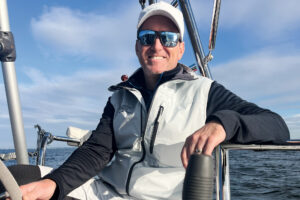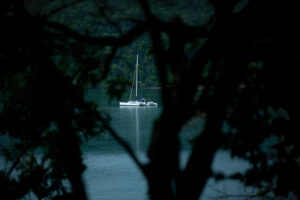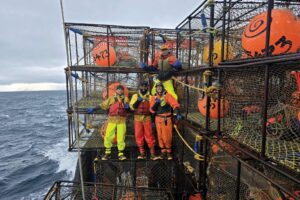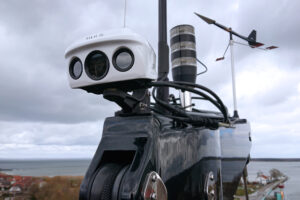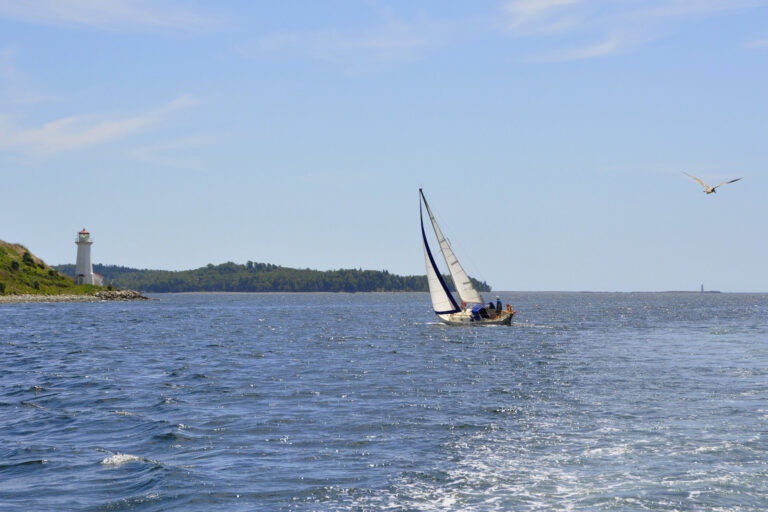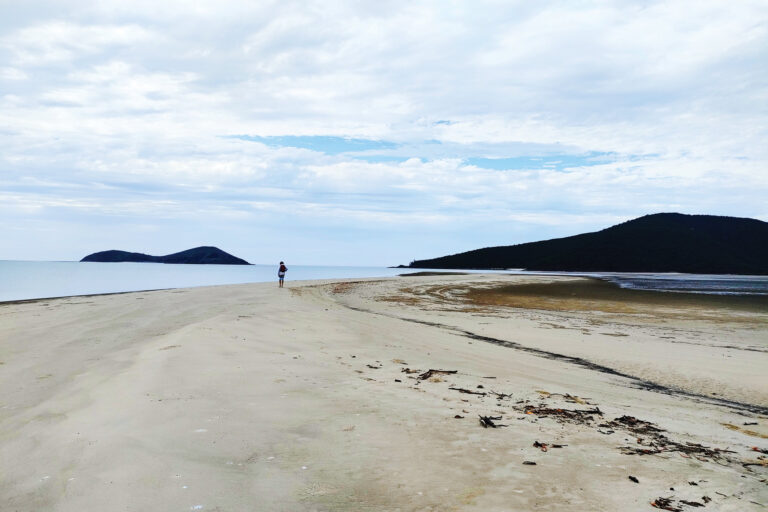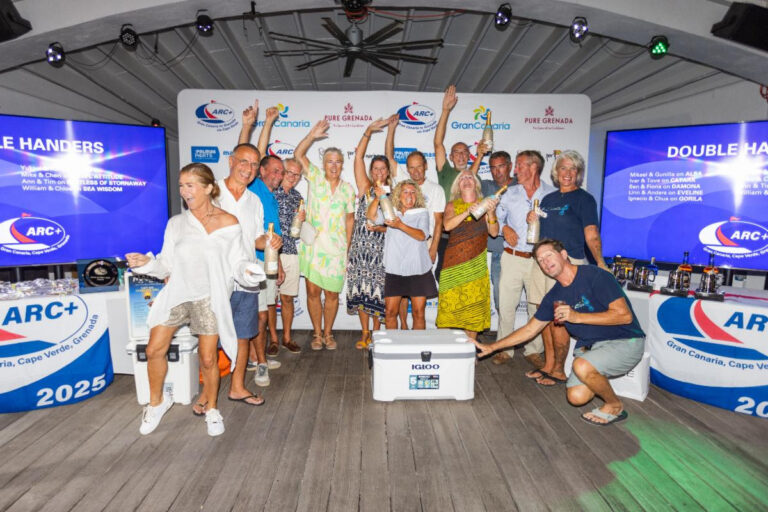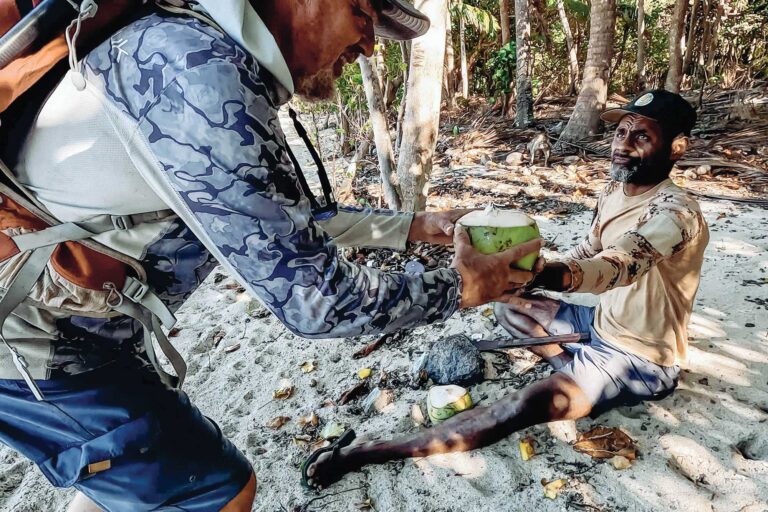| | (C) Jon Eisberg| Rolling deeply in the heavy northeasterly swell, riggers spread and birds in the water, a heavily laden trawler was inbound through Pollock Rip Channel southeast of Cape Cod, beating a slow but steady retreat from a winter stint out on Georges Bank. Any other time of the year, her captain would have ignored my 30-foot sloop, outbound on a reciprocal course, bashing to weather under staysail and double-reefed main. But whoever was in the wheelhouse that morning couldnt resist the urge to hail me, in that tone of mild condescension that professional mariners on occasion reserve for us amateurs: “Uhh, Captainyou sure you know where youre going? Have you listened to the weather?”
It was a fair question. Storm-force conditions were expected to develop over New England within 36 hours, and my 30-year-old Allied Chance 30-30 probably looked pretty small and vulnerable to his eye. For certain, his concern was genuine, as mine was very likely the first pleasure boat his crew had come across in months. Lest he think I was completely mad, I refrained from enunciating too clearly the name on her transom—Chancy—or the fact that I was bound for Maine. The calendar would have shown that April Fools’ Day was still a few weeks off.
|
| (C) Jon Eisberg|
Chancy had been acquired a few years earlier, turned into a major project, but never yet sailed for more than a day or two at a time. I’d hoped to take her south for the winter, but events had conspired to force me to settle instead for a three-week singlehanded trip from New Jersey to Maine and return. Yet, in late winter, it seemed somehow fitting that Chancy‘s shakedown cruise took us through some of the most popular cruising grounds anywhere—grounds in which I never spotted a single sail of another boat.
Cruising these waters in the wintertime, the complete absence of other cruising boats, the almost total desertion of many harbors, and the sense of emptiness out there lends a sort of gravity to the enterprise that’s palpable. Winds of equivalent strength are literally heavier in March than in August and might provoke reefing at a windspeed several knots earlier than normal. The spray obviously has a bit more sting to it than in the summertime, and the fact that it may freeze on deck imbues one with a sense of deliberation and caution regarding one’s movements often absent from warm-weather sailing. Clearing a fouled lobster-pot warp will definitely be more problematic than in summer, when a quick dip over the side is at least tolerable. Upon departing Pollock Rip Channel and feeling the surprisingly big sea running for the 25-knot northerly that was blowing, it wasn’t difficult to appreciate that, among other things, dying out there that night could be much more easily achieved than on a similar night “in season.” That sort of healthy respect for the elements, and for the consequences of a mistake, is a good deal easier to come by when the temperature hovers below freezing and the closest other sailing vessel under way just for the hell of it is likely a few hundred miles farther south.
| | (C) Jon Eisberg| Despite the general discomfort offshore and my lack of progress in the face of the sporty conditions, it felt marvelous to finally be taking my own boat somewhere Id dreamed of for a long time.
A breeze more northerly than forecast and a south-setting tidal stream off the cape had me making good on a course more toward Halifax than Penobscot Bay. If the predicted easterly didnt begin to fill in by later that night, I could always exercise the option to bail out and run for cover in Provincetown or Gloucester, but the real point of this cruise was a certain destination Down East, and I knew Id feel a considerable disappointment if I didnt make it that far. It was high time to begin the cruising life aboard my own little boat, and the most fitting start for me involved the delivery of a rustic little artifact to a place my father had always dreamed of sailing off to someday, yet never in his brief lifetime had the pleasure to see.
Early that evening, the breeze dropped to 10 knots and less, and I began the overnight slog across the Gulf of Maine under power. The expected development of a major noreaster left no time to dawdle out there, and I punched through a sloppy leftover head sea while maintaining a sharp lookout to starboard for the inbound procession of commercial fishermen returning to harbor. The cozy flicker of my diesel fireplace below mollified one of the coldest and blackest nights Ive ever experienced offshore, and the trade-off of the rejuvenating warmth for an intermittent reduction of night vision was a no-brainer. I felt, and must have looked like, the Michelin Man huddled up behind the dodger and wrapped up in countless layers of Capilene, fleece, and Gore-Tex.
| | (C) Jon Eisberg| Along with the cold comes a visual clarity rarely experienced in the hazy days of summer. The lights at Nauset beach and Highlands on Cape Cod, and later, the looms of Boston and Portsmouth, New Hampshire, appeared to be much closer than they actually were, and just before dawn I was treated to a spectacular air show: The contrails of jets homing in on Logan or JFK were beautifully lit by a rising sun yet unseen at my position. Just after sunrise, I was mesmerized by a low bank of concentrated, brilliant, white clouds off to the northwest. Another cup of coffee finally awakened me to the realization that I was staring at the broad, snowcapped shoulders of New Hampshires Mount Washington and the Presidential Range, easily 100 miles distantclearly not the sort of vision, or hallucination, one encounters on a typical summer cruise Down East.
I made landfall at Cape Small, about 20 miles east of Portland, around midday. The breeze finally had filled in from the east, and I sailed up the New Meadows River and into tiny Cundys Harbor. There are no public phones in the village, but the wonderful folks at Watsonsthe oldest family-operated general store in all of Mainetook a genuine interest in my early-season arrival under sail and kindly offered me the use of the stores phone to make an important call to my mother in Arizona. She watches the weather like a hawk whenever Im out on the water, and the handful of locals gathered there eavesdropped charmingly as I assured Mom Id be safe and sound during the impending blow and that I was keeping warm, eating well, and wearing my safety harness always. Then I was off to spend the night at anchor in the splendid solitude of The Basin.
| | (C) Jon Eisberg|
A quiet night in a place like this represents for me a good deal of what cruising is all about. The beautiful confines of The Basin may produce a marvelous, soulful experience at any time of the year, of course. To share that spot with a cluster of other boats during a busy summer weekend, rowing around the anchorage admiring other vessels and making new acquaintances, would certainly define one of the primary reasons we venture about in small boats. But for me, an arrival in a place like The Basin, and the knowledge that my anchor was likely the first to rest on its bottom in several months, fills me with a very special “sense of where you are” thats at the heart of my love of travel. Its no coincidence that the places I always feel most affecting are those where I sense the presence of my father and know that Im in the sort of place that he, too, would have loved to see someday.
Had a certain German mortar shell landed a yard or two this way or that along the banks of the river Elbe back in 1944, I would never have been born. As it was, my father narrowly escaped with his life, and he eventually returned home with a hip filled with shrapnel. Like so many others of their generation, he and my mother picked up the pieces, went back to work, and configured an extraordinary life for themselves and their family. Then, one beautiful April afternoon when I was 12, my dad walked out of his office on Manhattans Park Avenue into the brilliant sunshine, and one of those minuscule shards of German steel finally worked loose and accomplished its deadly mission. The last day of his life will forever be the defining moment of mine.
| | (C) Jon Eisberg| Whenever I attempt to trace the pedigree of my cruising dreams, I keep coming back to a snowy Friday night when I was perhaps 9 or 10. Bud, my big brother, and I were in the back seat of our DeSoto convertible, and our father was at the wheel, confidently and skillfully transporting his family through a Vermont snowstorm for a weekend of skiing at Mount Snow. The stretch of road between Bennington and Wilmington was a lonely bit of real estate in those days, and the reach of our headlights defined the limits of our safe and cozy little world. We’d drive for miles without seeing a light or another vehicle, and for all intents and purposes, that big hunk of stylish American steel could have just as easily been a small boat on a big ocean. I loved the excitement tinged with fear produced by that overwhelming sense of where we were, where we were headed, and the awe-inspiring appreciation of a young boy for the amalgamation of freedom and responsibility my father must have felt. That duality, for me, is at the heart of cruising, and I suppose it’s entirely fitting that my first real voyage aboard Chancy would feature a return to New England in wintertime.
My dad loved Friendship Sloops and Barnegat Bay catboats, in that order. One of his favorite musings was that one day wed go to Maine, acquire a Friendship, and spend the summer cruising Down East and sailing her back home to New Jersey. To a boy of my tender years, to whom Maine was an impossibly distant and exotic place, such a vision seemed the dream of a lifetime. Ive now outlived my father by several years, and Ive come to appreciate that ambition of his to be a relatively modest one, yet one entirely in proportion to the wondrous nature of the man. How he could have survived the great war he so bravely fought in yet never managed a simple cruise to a place he always dreamed of is about as cruel an irony as his brief passage through life presents to me and about as good an argument as Ive ever known in support of the oft-heard cruisers mantra, “Go now.”
My dad would have loved The Basin. Hed have noted its striking likeness to a lake in the Adirondacks. Most of all, hed have relished the fact that after dark, the only lights to be seen were above the tree line, thousands of light-years away. As I watched the sky darken and the water grow still, I opened a special bottle of wine given to me by a friend at the outset of my cruise. I drank a toast to my father, whod nurtured the dream that had brought me to this special place, and felt for the first time that my life as a cruising sailor had officially commenced. Although Id previously delivered other peoples boats to these waters numerous times, Id come to realize that sailing my own boat there, and leaving a small token of him there in the waters hed always hoped to explore, would be the most fitting way to honor both my parents.
| | (C) Jon Eisberg|
The following morning, I enjoyed a leisurely sail into Portland. Then I spent the next few days hunkered down in the lee of DeMillos floating restaurant, in the heart of downtown, as a wicked noreaster dropped copious amounts of rain and heavy, wet snow along the New England coast. Portland is a marvelous town in which to be stuck like that.
One of the harsher realities of off-season cruising is the fact that the weather dictates ones every move to a degree unimagined in more temperate seasons. I did a surprising amount of motoring through calms, because winter weather doesnt offer up much in between too little and too much breeze. And if my cruise was any indication, one must certainly be prepared to accept a fair amount of sailing and/or motorsailing hard on the wind. I was under way for almost 200 hours on this cruise, and I enjoyed an apparent wind aft of the beam for a total of barely seven.
| | (C) Jon Eisberg| However, the benefits of cruising New England way out of season are plentiful and various. The cost of dockage or moorage throughout one of Americas pricier cruising grounds is a fraction of the high-season rates: My extended stays in Newport, Nantucket, and Portland were surprisingly easy on my wallet, yet they featured all of the amenities one would enjoy in the summer save running water at dockside. True, theres a paucity of other cruisers out there with whom to mingle and make new friends, but one of the more striking aspects of this trip was the highly satisfying extent to which I became engaged with the local populace wherever I went. In the summertime, folks get pretty blase about seeing another sailboat come into harbor, but at this time of the year, I attracted genuine interest wherever I went. The kindness and generosity of complete strangers often appeared to be proportionate to the cold or the amount of snowfall on deck in the morning.
Arriving at the Nantucket Boat Basin on my way north, I enjoyed the thrill of being the only transient boat there and the first one to have passed through in several months. A modest community of liveaboards collects there in the winter, and shortly after my arrival, one of them came by to welcome me to town. He noted my home port in New Jersey, one thing led to another, and after a few minutes, he had me on his cell phone chatting with his fiancee. Just so happened she was, literally, the girl next door from my old hometown. Encounters of this sort, and reminders of the smallness of the world, occur all the time between cruisers, of course. But theyre far less likely to arise between a sailor and a commercial fisherman, for example, during the height of the season, and the frequency of that sort of interaction was indeed one of the more interesting and pleasurable aspects of my trip.
| | (C) Jon Eisberg|
My favorite travels always have a touch of weirdness to them, something thats far more likely to occur out of season, of course. One of my first indications that I was operating out of phase with normality was when I bought a copy of USA Today from its dispenser along the docks at Oak Bluffs on Marthas Vineyard. Not till I pulled out the sports section and began to read of the Yankees latest playoff success did I realize Id just purchased a newspaper almost 6 months old. In many of the spots I sailed to, life literally does come to a standstill at this time of year.
After leaving Portland and pinching up all day into a strong westerly in an effort to remain in the lee of the coast, I arrived at Gosport Harbor at the Isles of Shoals. As the only boat within miles, I was free to pick any mooring in the harbor. I was anxious to stretch my legs after the hard day’s slog to weather and to wander around the deserted village snapping some photos in the beautifully fading light. Shortly after I’d stepped ashore and popped off a few frames of Chancy sitting all by herself, the winter caretaker arrived on the scene. She politely, yet firmly, informed me that I must return to my boat immediately, as the Star Island Corporation’s insurance didn’t permit out-of-season visitation. Frustrated, I went back aboard to ponder awhile the sad reality—or surreality—of some corporate lawyer’s take on the nature of freedom and responsibility in the new millennium. Somehow, I’d found my way to this barren outpost in the latter stages of a thousand-mile singlehanded cruise on a small boat in the dead of winter, yet I couldn’t be trusted to meander around that tiny island for perhaps an hour without bringing harm to myself or possible financial ruin to its owners.
While I still enjoyed a beautiful night in that empty, windswept harbor 10 miles offshore, I was glad that my father wasnt along with me right then and that hed been spared that sorry glimpse of a world so changed from the one he knew.
| | (C) Jon Eisberg| The following day proved to be the single best sailing day of the cruise. Under way as soon as it was light enough to safely thread my way among the lobster pots that littered the harbor, I enjoyed a closehauled romp out around Cape Ann. I reached across Massachusetts Bay that sunny and warm afternoon, stunned by the clarity of the air, the solitude I enjoyed, and my ability to make out simultaneously the downtown towers of Boston and the bell tower at Provincetown.
Arriving as darkness fell upon Provincetown, the timing was perfect to satisfy my craving for a bit of good old American cultural junk food. This just happened to be the night of the Academy Awards, and I found a bar in this distinctively alternative communitys downtown that was hosting an Oscar party. Stuffing myself silly on the free buffet, I drank beer after beer with the locals as we cattily critiqued the fashion faux pas of half-naked starlets a full continent away. Gathered among that funky assemblage around the cool fire of the big-screen TV, suckling at the teat of Hollywood along with perhaps a couple of billion others worldwide, I was instantly absorbed into this relatively insular community in a manner to which cruising sailors quickly grow accustomed. The welcome I felt that night in P-town more than made up for the previous evenings rebuff, and I was overwhelmed once again by a powerful sense of where I was and by the debt Ill forever owe the parents responsible for inspiring the journey that had brought me there.
| | (C) Jon Eisberg| Thinking back on the trip after my lively evening ashore, thered been only one drawback that I could see to the splendid isolation of a place like The Basin. With no lights ashore, there were no obvious bearings to take just before darkness fell, so I was denied one of my favorite shipboard routines upon arriving at a new anchorage. A mundane little ritual of the cruising life from which I never fail to draw an exquisite pleasure, it took me back to a night over 40 years ago.
From summer-boyhood bunk beds that my dad had built for Bud and me, we could see through our bedroom windows the flashing reds of two of the channel markers defining the route of the New Jersey Intracoastal Waterway through Barnegat Bay. As I lay awake one night, no doubt sleepless in anticipation of some waterborne adventure planned for the following day, my dad, as loving fathers tend to do, slipped quietly into our bedroom long after we should have been asleep. Checking to make sure I was nicely tucked into my bunk, he was probably a bit startled when I asked him about what Id been fixated on for the previous hour or so: “Dad, how far is it to that red marker down off of Cattus Island?”
“Hmmm. Thats a good question. Lets go on out to the kitchen table, and Ill show you how to figure that out.” To the good-natured consternation of my mother, who would have set me up with a glass of warm milk, he pulled out a chart of Barnegat Bay, a set of parallel rules, and a pair of dividers. Well past my bedtime, my dad taught me for the first time the wondrous rudiments of navigation and dead reckoning. Thus was born my lifelong appreciation of “the sense of where you are” and the importance of getting ones bearings. After climbing back up the rope ladder hed made so Bud and I could get in and out of our bunks, I was, Im sure, half asleep before he might have uttered, “Tomorrow, what do you say we pick up a couple of charts of Maine for you to practice on?”
| | (C) Jon Eisberg| Two decades later, those bunk beds were finally dismantled in the transformation of the bedroom of my youth into a 1980s-style home office. But I couldn’t bear the thought of parting with that rustic rope ladder my dad had fashioned from 3/4-inch manila three-strand and 15 solid slats of teak. I hoped I’d find a fitting use someday for something he’d so lovingly crafted with his own two hands. As one of the last truly tangible pieces of my father remaining to me nearly 40 years after he left this world, I suppose it was inevitable that his handiwork would find its way into Chancy‘s lazarette before I headed off to Maine.
Sitting in her cockpit that evening after reaching The Basin, the meaning and purpose of that simple rope ladder became clear to me at last. With the same startled surprise with which Id finally recognized Mount Washington early that morning, I fished it out of the cockpit locker and cut off one of the steps. With the solemnity and purpose of one scattering a beloveds ashes, I let that first rung slip over the side, and I watched as the ripples spread out over the mirror that was the surface of The Basin. A small part of my father had finally made it under sail in a small boat to the sort of place hed always dreamt of being. For a man whod always put others first and whod shouldered his responsibilities so honorably throughout his life, a minuscule but very meaningful part of his soul was now free to drift wherever wind and tide conspired to take him.
Fourteen rungs of his creation remain to be cast adrift in places Ive yet to see and know my father deserved to see as well. Uncommon places, off the beaten track, ones as simple and elegant as the man himself. Perhaps the Lofoten islands someday, or Pitcairn. Niue and St. Helena are definite maybes, and New Zealands Milford Sound is awfully high on my list, as are the Chagos Archipelago and the Skeleton Coast of Namibia. Cape Horn and South Georgia are my own personal Everests, but well have to wait and see whether I ever manage to attain those. Diamond Shoals off Hatteras should be in the cards, and, of course, Ill have to set one rung aside for that eventual day when Ill have seen about as much of the world under sail as Im going to see.
| | (C) Jon Eisberg| That last rung Ill save for the shallow, brackish waters of Barnegat Bay, somewhere in the vicinity of that red flasher near Cattus Island.
Jon Eisberg learned to sail on Barnegat Bay, New Jersey, and makes his living photographing Grand Prix and Indy auto racing and delivering yachts up and down the U.S. East Coast. Next winter, he hopes to take Chancy to warmer waters.

